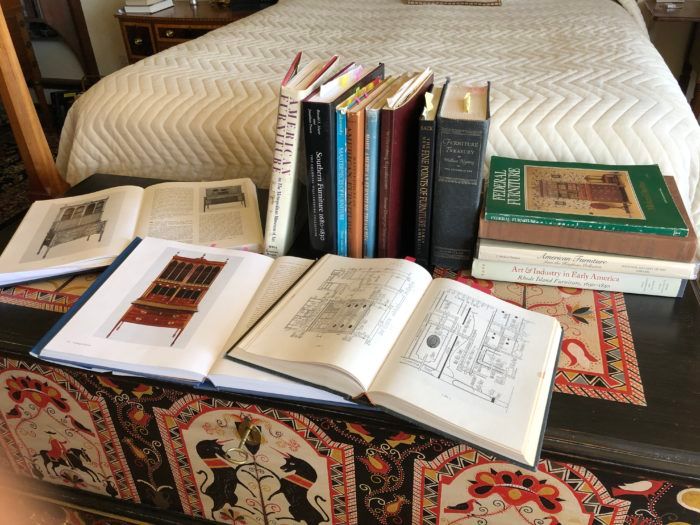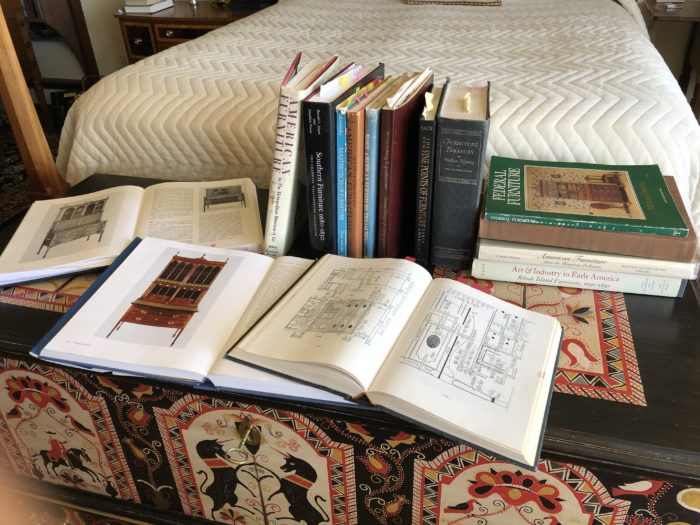The hard work of starting a new project
Even though there is no space in his house for one, Tim Killen begins the planning process for his newest project, a Seymour secretary bookcase.
I suspect I’m not alone in stressing over the selection of a new project. It always happens – I just finish a project (probably taking several weeks) and again I’m faced with the dilemma, What’s next? It used to be easy – there were specific needs in the home, an extra bed, dining room chairs, a chest of drawers, more bookshelves, etc. After those needs were fulfilled, the kids had urgent requests. Now all these drivers are gone – and there are no empty spaces to fill in these multiple homes. In fact, there is now a problem – where to put any new creation!
So here I am again, waking at night hoping a great idea is revealed; and during the day, surrounded by furniture books, some of which are shown below. For days, these heavy and large books are strewn across various tables and desks in the house, displaying little colored stickies on pages of possible interest. What period and style should I select this time? Should it be a new challenge, requiring complex shapes, intricate carvings, inlay decoration, painting I’ve not done before? It is a stressful period.

This time a student bailed me out – suggesting a difficult piece, a challenge, something new to me, and not on my radar. Even though there is no need and no space in the house for this project, I’m totally on board and enthusiastically beginning the next stage, research.
The planned piece is a Seymour Secretary Bookcase shown in the book “The Furniture Masterworks of John and Thomas Seymour”. This bookcase is also displayed on the back cover of the book, as shown below. I’ve done one Seymour piece, a Ladies Worktable, and like this style very much.

Typically for me, there are no drawings and detailed information for these 18th C. museum pieces I like to reproduce. I’ve gone through all my Margon, Nutting, Gottshall, Greene, Marlow, Hayword, Dunbar, Salomonsky books without finding a similar piece. Also I begin an online Internet search and search Google Images and Pinterest looking for pictures, sketches, drawings that may be useful. I search the SAPFM site, FineWoodworking.com, and other sites for applicable articles and pictures. The Museums are also great resources for pictures in their online Collections, particularly The Metropolitan Museum of Art. This specific Seymour piece is located in the Peabody Essex Museum, however I could not find an online picture there.
So for now, I’m shifting away from the research and scientific stage of development, to the engineering stage of creating a detail design with the scant information on hand. Unfortunately, the photos in the Seymour book, although great looking, are dodgy in SketchUp. I tried PhotoMatch and could not achieve a good alignment of the perspective bars. So it is likely the photos in the book were somewhat “doctored” or cropped. I’m stuck with importing the photo, “As an Image”, and making the best of it.
Here’s the current stage….

After importing the book’s photo “As an Image”, I straightened it to align with SketchUp’s red and blue axes. Then I resized to the overall dimensions in the book so that I had a full-sized bookcase. You can see my traced-over shapes on top of the photo image, and these were used to create the preliminary 3D components as shown below.

I’ve worked additional detail on the Tambour section. It consists of two boxes, an inner and an outer that includes the track for the Tambour doors. One door is shown in the open position, so you see slats that are in the track at the back edge of the box. Much more work to do on the joinery.

At this stage, there is no joinery, inlay decoration, molding shapes, drawers, finials, or hardware. I want to make sure of this preliminary structure and sizing before getting into those details. Note there are three separate structures – the lower case with the hinged writing table, the middle case with pigeon holes, drawers, and tambour doors, and the top bookcase.
Since this will be my first construction of tambour doors, I’ve been looking for helpful information. One source is a Nutting drawing in his Furniture Treasury book as shown below. It’s not a Seymour desk, but shows the accommodation of tambour doors including the layout of the track or groove. I’ve used this to work the inside structure of the middle case, giving space for the grooves in which the doors slide.

Here’s the video of this SketchUp work…..
Tim
KillenWOOD.com
 |
|
 |
|
 |
Fine Woodworking Recommended Products

Sketchup Class

Blackwing Pencils






















Comments
Wow. Nice job.
I can't tell from your pile of books, but are the Vernon Stoneman volumes on the Seymours in there?
John, those two books are not in the pile. I have one of Stoneman's, the Supplement. The other one is on order. I've reviewed both and seeing more pictures is helpful. However, there is only one picture of this secretary and it is not any better than the one I have in SketchUp.
Tim
Looking at as many images as you can is very helpful. Sometimes seeing similar pieces helps even more than the one you're going to reproduce.
I've been to the Peabody Essex Museum many times. Seeing some of this furniture in person really changes everything.
Thanks John, if you are there again, can you take more pictures? I envy your capability to see the pieces in the museum. Located here in CA makes it very difficult to visit those important places.
Tim
Log in or create an account to post a comment.
Sign up Log in